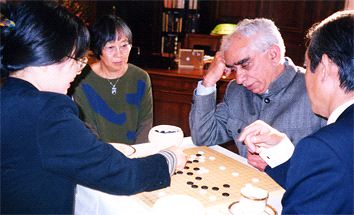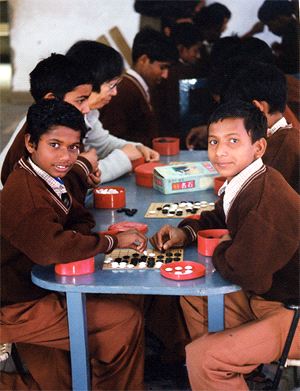 |
|
| Teaching Go in India | |
 |
|
| Teaching Go in India | |
 |
Last month I skipped a season, flying to India, where summer has already begun, to teach go. Two years had passed since my last visit. I stayed for three weeks and visited three cities: Mumbai, Delhi, and Aurobiira [phonetic transcription]. Ms. Takechi Harumi, who introduced me to the Aurobiira go group, flew over from Japan specially to accompany me on my tour, which was very reassuring. After all, with my knowing so little about India . . . In Japan, Ms. Takechi is just an ordinary woman, but as a go player she is known around the world. She's a superwoman who spends several months every year overseas, participating in go events and visiting friends. In particular, she goes to Russia every year and has been appointed an honorary counselor to the Russian Go Association. In Delhi I taught at two elementary schools that I first visited two years ago and also taught a group in the Japanese Association. I also had an opportunity to teach the fundamentals of go to the Indian Foreign Minister Mr. Singh. Mr. Singh had apparently been interested in go for some time and had been hoping for a chance to be taught by the Japanese Ambassador to India, Mr. Hirabayashi, but his duties as Foreign Minister had kept him too busy, so my lesson was his introduction to go. On the appointed day, four of us -- the Ambassador Mr. Hirabayashi, Harumi, a journalist, named Nakajima-san and myself -- visited the Ministry of Foreign Affairs, and, after passing through various inspection devices, were ushered into the Minister's office. On Mr. Singh's desk was a go set that he had got the Indian ambassador to China to buy for him. Speaking in a quiet, rather thick voice, like that of the actor Tamba Tetsuro, in English that, unusually for me with Indians, I could understand, Mr. Singh said: 'Oh, I'm so sorry I made the Japanese Ambassador, who's so busy, come too.' His office had a tasteful, burnished elegance; there was just our group and his secretary (quite a handsome gentleman). 'I'm greatly interested in go because I want to study strategy,' said Mr. Singh, who originally made his career in the army and is descended from maharajahs. His motive for learning go was different from that of the usual beginner. After a simple explanation of the rules, Mr. Singh immediately wanted to try a game. I expected the ambassador or Harumi to play him, but they said as one, 'Since we have a pro here --', so I couldn't resist. I was just wondering what the handicap would be when Mr. Singh took the bowl of white stones and said in his thick voice, 'Let's play!' To play a beginner who had just learnt the rules (after a fashion) on even! I was shocked: it would be a very difficult task not only to make the game look like go but also to make it enjoyable for my opponent. Perhaps you can understand my feelings. After I retrieved the white stones, we played a game in a friendly atmosphere, ending up with an explanation of how to rearrange the territories for counting. It was almost a miracle that we got through a whole game safely. Aurobiira is 300 km south of Madras; it's a pioneering community of people who lead a self-supporting life; nationality and race are irrelevant. It began 30 years ago by planting trees in this area, which was formerly desert, and now has a population of 1500. It's a large village, or organization, with the inhabitants 50-50 Indian and foreign. It is surrounded by various kinds of tropical trees -- it's like a paradise. Can you imagine what it's like? And there are go fans here! About 30 of them, all told, holding meetings every Sunday but also playing any time the go players are free. None of the local Indians are members -- instead, they are immigrants from overseas, such as Germans, Italians, Dutch, etc. Almost all of them learnt go here. They are now interested in teaching children in the village schools. I wonder what will happen. It's something to look forward to. (Monthly Go World, May 2000) |
 Å@Å@Å@ Å@Å@Å@ |
 |